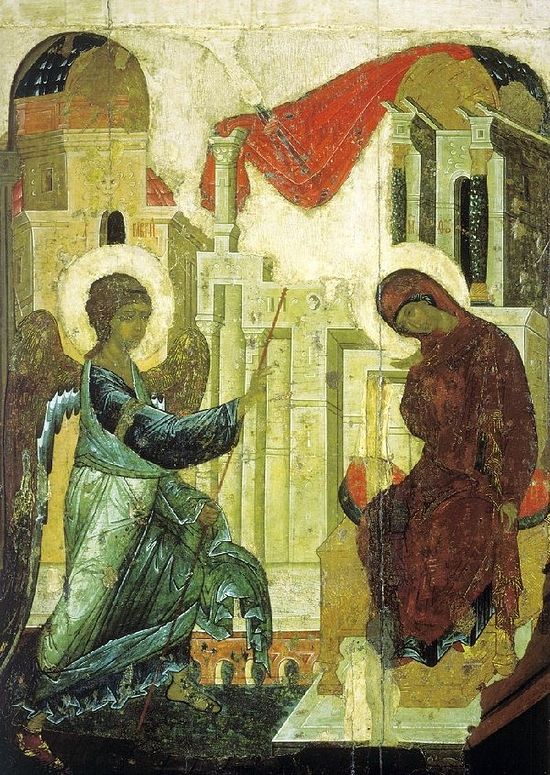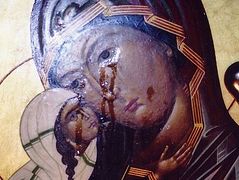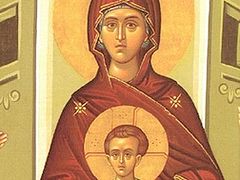Source: Pemptousia
March 25, 2016
Holy and Great Lent began a few days ago and the atmosphere is already solemn and mournful, as befits this period of time. It’s the sweetest and most beautiful time of the year, since it provides us with a great opportunity for prayer and repentance, and deep contrition strengthens this desire.
The liturgical life of the Church includes beautiful and solemn services, such as Solemn Vespers, Great Compline and the Salutations to Our Most Holy Lady the Mother of God, which give us special strength. And as we know, Our Lady is our greatest intercessor to God. Why has the Church placed the Salutations to Our Lady in Great Lent? What connection can they have with the Passion and Resurrection of Our Lord, which we are soon to experience?
The role of Our Lady in the life of each of us is enormous. She intercedes for us with God the Father for the salvation of our soul. It is for precisely this reason that the Church has chosen to place the service of the Salutations in Great Lent. Through this service, we all ask our Mother to support us in the struggle we began just a few days ago. To pray to God the Father for the salvation of our soul, for a good outcome for our efforts, that they will be peaceful and sinless and that we may, with a pure soul, experience the Holy and dread Passion of Our Lord and, thereafter, His splendid Resurrection. The presence of Our Lady in the world is of great and saving significance both in our everyday lives and, especially, at events of great moment, such as hostilities.
‘Hail, for through you the banners are raised; hail, for through you our enemies are fallen’
It’s worth mentioning here a historical event, as an example and proof of the timely intervention of Our Lady in the history of the world.
In the year 626, when the emperor, Irakleios, was campaigning with the imperial army against the Persians, Constantinople was unexpectedly besieged by Arabs. The Arabas rejected every proposal for a cease-fire and, on August 6, captured Our Lady of Vlakhernai. In collaboration with the Persians, they prepared for the final attack, while Patriarch Sergios carried the icon of Our Lady Vlakhernitissa around the walls of the city and encouraged the people to resist.
That night, a dreadful tempest, which was attributed to divine intervention, caused a storm and destroyed the enemy fleet and the defenders inflicted devastating losses on the Arabs and the Persians, who were forced to raise the siege and depart empty-handed.
On 8 August, the city was saved from what was until then the greatest threat in its history. The people wanted to celebrate their deliverance, which they attributed to the intervention of the Mother of God, and gathered at the Church of Our Lady of Vlakhernai. There, according to tradition, the crowd stood and sang what has ever since been known as the Akathistos Hymn (i.e. ‘without sitting’), an ode of thanksgiving to the defender and commander of the Byzantine state, offering her ‘hymns of victory and thanksgiving: ‘To you, the defender and commander…’.
That is a vivid example of the intervention of Our Lady in the history of the world. Her intercessions deliver whole nations, so how much more easily can she redeem our souls through her prayers to God for our salvation, ridding us of our passions? Through her ‘the banners are raised and our enemies fallen’ (4th section). She’s ‘the passage through the gates of Paradise’ (2nd section) and ‘the bridge leading us from earth to heaven’ (1st section).
The introduction of the Akathistos Hymn and its division into sections
The Akathistos Hymn was introduced in 626 as an indication of profound gratitude to Our Lady and is divided into sections, each beginning with the corresponding letter of the Greek alphabet. It’s also known as the Service of the Salutations and is sung, in sections, on the evening of each Friday of Lent, and in its entirety on the fifth Friday. It is believed that the composer of the hymn was the great hymnographer Saint Romanos, while the canon of the Salutations which is sung before each section is attributed to Saint Iosif the Hymnographer.
The saving nature of the Salutations
From all of this, we may understand that it is no accident that the Salutations have been placed within Great Lent. What we will experience shortly is the most tremendous experience, and our soul must be pure if we are to live through the Holy Passion and the splendid Resurrection of Our Lord. This is why we ask Our Lady to support us at this time with her maternal affection and love, to pray for us to Our Father and for us to complete both this struggle which we are undertaking this Lent, peacefully and sinlessly, and also every other struggle for our salvation, so that we may enjoy the Kingdom of God. This is precisely what is expressed by the verse in the 3rd section ‘Hail, the key to the Kingdom of Christ’ and in the last verse of the 4th section, ‘Mother worthy of all praise… accepting this our offering, deliver from every evil and from the punishment to come all those who cry to you: Alleluia!’.




